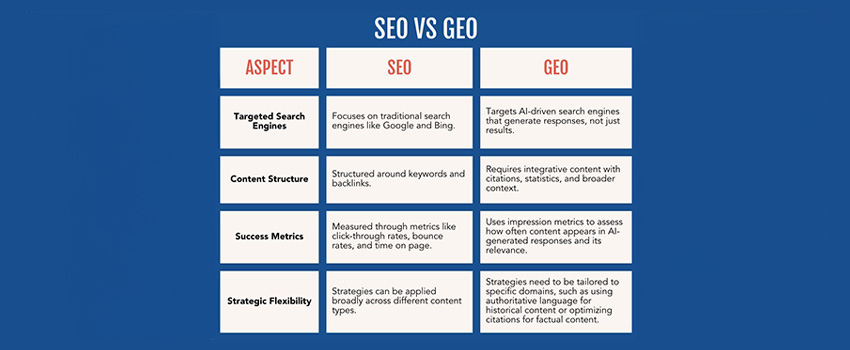
Search as we know it is changing. The familiar world of keyword searches and ranked website lists faces disruption from artificial intelligence that answers questions directly. Gartner research shows traditional search volume will drop 25% by 2026, with organic search traffic declining over 50% as AI-powered search gains ground.
Generative engine optimization (GEO) addresses this shift head-on. While traditional search engines crawl, index, and rank web pages, GEO ensures your content appears in AI-driven platforms like ChatGPT, Perplexity, Gemini, and Copilot. These tools are reshaping how people discover information and connect with brands. Currently, 79% of consumers plan to use AI-enhanced search within the next year, and 70% already trust generative AI search results.
The numbers tell the story. ChatGPT maintains over 180.5 million monthly active users. Perplexity AI’s search volume has jumped 858% in the past year, reaching approximately 10 million active monthly users. Put simply: SEO helps humans find information, while GEO helps AI use it effectively.
This guide explores generative engine optimization, its differences from traditional SEO, and its importance for digital visibility in our AI-driven world. We’ll provide practical strategies to help you adapt your content for this new search reality.
What is Generative Engine Optimization (GEO)?
Generative Engine Optimization (GEO) emerged as a strategic marketing approach that extends beyond traditional search methods. Initially coined in November 2023 by six researchers in an academic paper, GEO represents a shift in how brands position themselves within the evolving search environment.
GEO definition and purpose
Generative Engine Optimization optimizes your website content for visibility in AI-driven search engines including ChatGPT, Perplexity, Gemini, Copilot, and Google AI Overviews. Traditional SEO delivers lists of links. GEO makes your content attractive to AI systems that generate complete, contextual answers directly for user queries.
GEO bridges the gap between what users need and what search engines deliver. This approach provides rich, credible information that answers user searches while addressing related questions they might have. The goal remains clear: position your brand to appear in AI-generated results when users search for topics related to your products, services, or expertise.
We’ve identified four core functions where GEO tools operate:
- Analyzing User Intent: Examining search patterns and browsing behavior to understand specific user needs
- Generating Content: Creating targeted material that answers user questions while meeting modern search standards
- Optimizing Content: Improving readability, structure, and visibility elements
- Personalizing Content: Delivering customized experiences based on user demographics and past interactions
How GEO fits into modern digital marketing
GEO is changing how search engines present information and how users consume it. Better visibility in AI-generated responses has become essential for brand discovery in modern digital marketing.
The shift carries weight. Traditional search volume is expected to decrease by over 50% by 2026. Meanwhile, 79% of consumers plan to use AI-enhanced search within the next year. This makes GEO a necessary component of complete digital marketing rather than an optional add-on.
GEO serves as the bridge between traditional web presence and AI visibility. When you optimize for AI, you meet users where they search and provide the relevant content they want, expanding your reach while improving user experience.
What is generative SEO vs traditional SEO
Traditional SEO and Generative Engine Optimization share similar goals but use different methods. Both work to improve content visibility in search results and drive meaningful engagement. They focus on website visibility, organic traffic growth, and user engagement through well-crafted content.
The approaches differ in key areas:
- Focus: Traditional SEO emphasizes keywords, meta tags, and technical structure. GEO prioritizes understanding user intent and creating content that adapts to changing needs.
- Tools: SEO uses keyword research platforms and manual content reviews. GEO employs AI-powered platforms that analyze data and optimize based on real-time user behavior.
- Content Structure: SEO optimizes meta tags with keywords for better rankings. GEO ensures content clarity and relevance, enabling AI algorithms to generate accurate responses.
- Measurement: SEO success comes from rankings and traffic metrics. GEO success comes from citation frequency and brand representation in AI-generated content.
SEO helps your content get discovered. GEO helps it get included in answers. The best approach combines both strategies to maximize your digital presence across traditional and AI-driven search environments.
How GEO differs from traditional SEO

Traditional SEO and generative engine optimization share common objectives but operate on entirely different principles. The shift from link-based to language-based discovery demands a complete rethinking of content strategy.
Content structure and formatting
Traditional SEO builds fully developed web pages with hero images, meta descriptions, and keyword-rich content spanning 1,500+ words. GEO takes a different approach, prioritizing surgical snippets that AI can easily extract. Your content must deliver definitive answers within the first 50 words, supported by bulleted evidence or structured data.
Format matters significantly. AI engines favor content that’s modular, semantically rich, and easy to parse. Research demonstrates that LLMs are 28–40% more likely to cite content with structured formats like headings, bullet points, and clear Q&A blocks.
Keyword placement becomes less critical in GEO. Token efficiency takes precedence over keyword density—delivering maximum information with minimum words. AI models prefer content that reads like a complete, trustworthy answer rather than keyword-stuffed paragraphs.
User interaction and search behavior
Search interaction has evolved dramatically. Traditional search users type short keywords (averaging 4 words) and browse ranked results. AI-native search users ask conversational questions averaging 23 words.
The information consumption model has changed completely. A Bain & Company study reveals that 80% of users answer 40% of their queries without clicking a link. Users receive complete answers directly from AI rather than navigating to websites.
This creates a new success paradigm: SEO aims to win clicks from website links, while GEO focuses on inclusion in summaries or conversational responses. Your goal shifts from ranking high on results pages to becoming the quoted source in the answer itself.
Performance metrics and visibility goals
Success measurement differs significantly between these approaches:
Traditional SEO metrics:
- Organic traffic
- Keyword rankings
- Click-through rate
- Bounce rate
- Conversions from search
GEO success indicators:
- Citation frequency in AI tools
- Brand mentions in AI answers
- Share of voice in AI platforms
- AI referral traffic
- Contextual accuracy of mentions
This reflects a fundamental conversion model shift. SEO converts impressions into clicks that drive traffic; GEO converts impressions into citations that build authority. Traditional SEO celebrates a 5% CTR, while GEO success means being the source line under a zero-click response—even if traffic remains flat.
Both optimization strategies remain essential during this transition period. SEO continues building the foundation, while GEO ensures your brand visibility carries into the AI-driven search landscape.
Why GEO matters in today's AI-driven world
Comparison chart showing SEO focuses on search ranking and backlinks, while GEO involves AI content and personalized experience.
Your digital marketing strategy needs to evolve with the search landscape. AI is reshaping how customers discover information and connect with brands, making generative engine optimization essential for maintaining competitive advantage.
Shift in user search behavior
Search behavior has changed dramatically. Users now ask complete questions rather than typing short keyword phrases. Where traditional searches averaged 3-4 words, AI search queries span 10-20 words as people expect conversational interactions and immediate, complete answers.
The most significant change? Approximately 80% of AI search users complete 40% of their queries without clicking any website links. This “zero-click” behavior means users receive direct answers within AI interfaces rather than navigating to external sites. For businesses, this represents both a challenge and an opportunity to be the source that gets quoted.
Rise of AI platforms like ChatGPT and Perplexity
The growth rates speak for themselves:
- ChatGPT reached 100 million weekly active users faster than any platform in history
- Claude AI surpassed 10 million weekly active users within months of launch
- Perplexity AI has grown over 850% year-over-year, processing over 10 million daily searches
- Microsoft Copilot integrated AI search directly into Windows
These platforms aren’t supplementing traditional search—they’re replacing it for many users. Industry analysts predict AI will handle over 50% of all search queries by 2026, creating an entirely new discovery ecosystem.
Impact on organic traffic and brand visibility
This shift creates real business implications. Many websites report 15-30% traffic declines in categories where AI search has gained traction. Companies optimizing solely for traditional search face potentially significant visibility losses.
However, disruption creates opportunity. Brands appearing frequently in AI-generated answers gain unprecedented authority positioning. When AI cites your content as a primary source, you establish instant credibility, often reaching users who would never have clicked through traditional search results.
We help businesses navigate this transition effectively. GEO bridges the gap between traditional web presence and AI visibility, ensuring your expertise remains visible regardless of how users search. The goal is securing your place in both current and future search landscapes while your competitors adapt to this new reality.
How generative AI engines work

Every AI-powered search result stems from sophisticated technical processes that determine which information appears and how it gets presented. Understanding these mechanisms helps you optimize content effectively for generative search.
Generative AI starts with foundation models trained on massive datasets – typically terabytes of text from the internet, books, and other sources. During training, these models perform millions of “fill in the blank” exercises, constantly adjusting to predict the next word or element in a sequence. This creates neural networks with billions of parameters that encode language patterns and relationships.
Natural language processing (NLP) breaks human language into components that machines can understand. Modern NLP relies on transformer architectures that create “attention maps” capturing relationships between words and phrases. This allows AI to grasp not just individual words but complete linguistic contexts.
Understanding user intent and context
AI must determine what users actually want when they submit a query. Intent classification analyzes each input to categorize it appropriately – whether someone seeks information, wants to change settings, or needs another action.
AI systems analyze semantic properties of queries, identify relationships between concepts, and infer the user’s underlying goals. This process involves tokenizing queries, comparing them against known patterns, and determining the most likely intent classification.
Content generation and citation logic
AI engines use two primary approaches to generate responses. Model-native synthesis pulls exclusively from patterns learned during training – creating coherent but sometimes inaccurate content from probabilistic knowledge. Alternatively, retrieval-augmented generation (RAG) actively searches external sources in real-time before synthesizing responses.
This explains why engines like Perplexity consistently cite sources while ChatGPT often generates answers from memory. RAG-based systems trade some speed for improved accuracy and citation capabilities, making them better suited for research-oriented queries that require verification.
How to optimize your content for GEO
Success with generative engine optimization requires strategic adjustments to how you create and structure content. The right combination of technical setup, content formatting, and distribution tactics can significantly boost your visibility in AI-generated responses.
Use of structured data and schema markup
Schema markup creates a direct line of communication with AI systems. This standardized format tells search engines and AI models exactly what each page element represents. Sites with proper schema markup implementation see up to 25% higher click-through rates compared to those without structured data.
Focus on these high-impact schema types:
- FAQPage schema for frequently asked questions
- HowTo schema for instructional content
- Organization schema for brand identity
- Product schema for e-commerce pages
Schema markup eliminates guesswork for AI engines, making your content more likely to appear in generated responses.
Creating modular, semantically rich content
AI engines extract meaning from well-structured sections rather than reading entire pages. Treat every H2 heading as its own focused answer. Build modular sections between 75-300 words that provide complete value independently.
Structure drives selection—content with clean headers, direct answers, and transparent sourcing becomes far easier for AI to cite. Lead each section with a clear answer in the first 1-2 sentences, then provide supporting evidence.
Building brand authority and trust signals
Authority now extends beyond traditional SEO signals to become crucial for AI visibility. Your goal: become the most easily retrievable, highly corroborated source in your field.
Trust signals matter enormously. Include detailed author credentials, reference reputable sources, and keep content fresh through regular updates. Research indicates content with citations and quotations achieves up to 40% more visibility in AI-generated responses.
Distributing content across AI-friendly platforms
Your website alone won’t cut it. ChatGPT frequently cites Wikipedia (7.8% of citations), while Reddit dominates across platforms including Google AI and Perplexity.
Pursue mentions in industry publications through strategic PR efforts. The most effective approaches combine on-site optimization with smart distribution across platforms that AI systems regularly reference.
Tracking AI visibility and mentions
Start by ensuring AI platforms can access your content—allow AI user agents like GPTBot and CCBot in your robots.txt file. Monitor both citations (when your URL appears in answers) and mentions (when your brand gets named without linking).
Define 10-20 key business-related questions and test them regularly across AI platforms. For deeper insights, consider specialized tools like AI Visibility from Amplitude or SE Ranking’s AI Results Tracker to monitor your brand’s presence in AI-generated responses.
Conclusion
Search has reached a turning point. Traditional SEO alone won’t secure your digital future as AI reshapes how people find and consume information. Businesses that adapt now will thrive tomorrow.
This exploration reveals a clear reality: GEO operates differently from conventional search optimization. Traditional SEO drives clicks to web pages. GEO gets your brand cited within AI answers. This shift demands content that delivers clear, immediate value in formats AI can easily understand and reference.
User behavior confirms this transformation. Conversational queries and zero-click searches have become the norm. Platforms like ChatGPT and Perplexity continue their rapid growth, creating an entirely new discovery ecosystem.
Success requires understanding AI engines and optimizing accordingly. Schema markup, modular content structure, and strategic platform distribution improve your visibility in generative search results. Building your brand as an authoritative, trustworthy source remains crucial.
The winning approach combines both strategies. Traditional SEO drives today’s traffic. GEO secures tomorrow’s visibility. You don’t choose between them—you implement both effectively.
Generative Engine Optimization represents more than new tactics. It’s a complete rethinking of digital visibility. Brands that move quickly will secure their place in AI responses, maintaining relevance as search technology evolves.
The future of search is here. Those prepared for it will lead the way.




